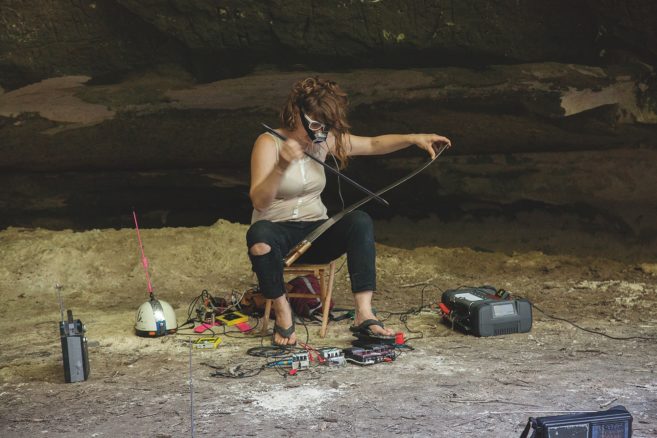Our impact on the earth is so total that it can be difficult to see at all. Looking requires special effort. It also tends to necessitate action. Between looking and not looking, it’s much easier not to look. For the past 35 years, photographer Edward Burtynsky has tried to visualize the immensity of our industries and the ways they are refiguring the landscape. With helicopters and drones, he seeks a better vantage and a fuller glimpse. His camera records quarries and mining operations like wounds on the body of the planet. The images are collected as evidence that, to the detriment of most else, we are living in the Anthropocene, the epoch of the human.
At the end of September, Burtynsky, along with filmmakers Jennifer Baichwal and Nicholas de Pencier, presents a major exhibition at the Art Gallery of Ontario and the National Gallery of Canada that, according to press materials, “tells the story of human impact on the Earth.” Museums are regularly forums for such big ideas. But seldom do we consider: are they also places that practice them? Art- and exhibition-making are not without their environmental costs. What are their impacts? And what are cultural institutions doing to mitigate them? There are a growing number of organizations and arts workers who are now choosing to look.
“Museums have an enormous responsibility; at the same time, they have an enormous ability,” says Sarah Sutton, who runs a consultancy helping galleries, zoos, historic sites and the like become more sustainable. Her handbook The Green Museum, co-authored by Elizabeth Wylie, is considered a go-to on the subject. Museums have a commitment, she explains, to the community that shares their environment. The same institutions also happen to be creative problem solvers, skilled presenters and trusted authorities. “I think they’re one of the best places to make this difference.”
John McAvity, until recently executive director of the Canadian Museums Association, shares the sentiment: museums can be role models. (The CMA published its own guidebook in 2015 detailing best practices.) He sees the opportunity for cultural institutions to be “showcases for environmental conservation,” where the 75 million people who visit Canadian museums each year see what sustainable operations look like.
The manner in which an institution addresses its carbon footprint tells us a lot about how it regards its purpose and its responsibility. The question at the core of the matter is simple: what is it that a museum does? If its role is to serve and educate the community, then dedication to better stewardship might extend beyond the care of a collection—it might mean that it’s the museum’s job to take better care of its environment too.
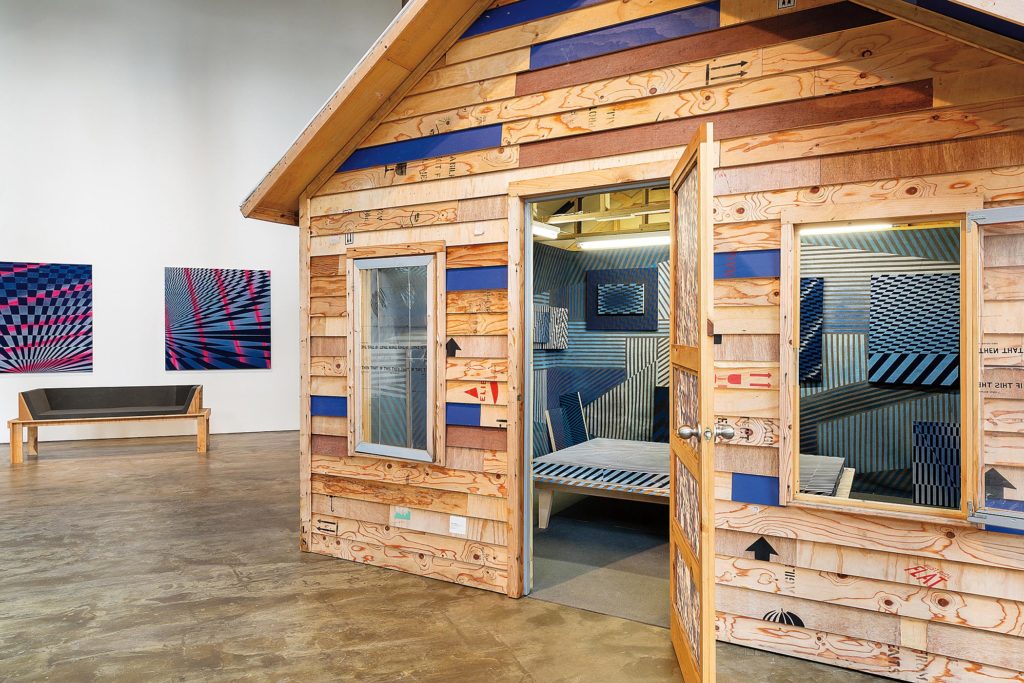 Ghost of a Dream, Fair Housing Project: When the Smoke Clears (detail), 2016. Discarded art fair ephemera (shipping crates, carpet, pedestals, wall vinyl, swag bags, packing foam, banner, tape and hardware) collected from Art Basel Miami, The Armory Show, Frieze New York and London, ADAA and Spring Break, 3.1 x 3.1 x 3.1 m. Photo: Etienne Frossard.
Ghost of a Dream, Fair Housing Project: When the Smoke Clears (detail), 2016. Discarded art fair ephemera (shipping crates, carpet, pedestals, wall vinyl, swag bags, packing foam, banner, tape and hardware) collected from Art Basel Miami, The Armory Show, Frieze New York and London, ADAA and Spring Break, 3.1 x 3.1 x 3.1 m. Photo: Etienne Frossard.
An art gallery isn’t as bad as the refineries and oil fields Burtynsky photographs. On the other hand, it’s probably worse than the typical insurance broker’s or dentist’s office. The impact of an art gallery is likely larger than you’d imagine. When asked if there’s a building or some facility she’d compare, Vivian Manasc, an Alberta-based architect who specializes in sustainable design, estimates that an art gallery probably has two to three times the environmental impact of a similarly sized commercial office. I ran the figure past Sutton, who thought it was in the ballpark. Galleries draw considerable energy, mainly to power extensive lighting systems meant for display, and powerful heating, ventilation and air-conditioning (HVAC) equipment tasked with maintaining precise settings throughout large spaces 24 hours a day, seven days a week, regardless of the season outside. There is no standard in the sense of a specification that’s ratified by a standards body, a senior conservation scientist with the Canadian Conservation Institute explained to me, but guidelines from various organizations have established an unofficial though commonly held practice that’s contractually required by many lending institutions. It’s called the 70/50 rule: the environment of a gallery is generally kept within five degrees of 70 Fahrenheit and at 45 to 55 per cent relative humidity. Add to those elevated energy demands a not-insignificant stream of office, food and construction waste from new installation projects, as well as the carbon emissions from shipping and travel, and the average art museum racks up a sizeable footprint.
Green design begins with the basics: walls, windows and roofing. If she were building a sustainable gallery from scratch, Manasc says, she’d start with a high-performance building envelope—airtight and well-insulated to maximize HVAC efficiency. If you’re upgrading an existing building, she says, your starting point would be the lighting. LED bulbs, for instance, use approximately 75 per cent less electricity than traditional incandescent bulbs. Building automation systems rigged with detection devices such as carbon-dioxide, occupancy and light sensors can optimize mechanical performance and save needless expenditures by, say, prioritizing natural light or dimming a room when unoccupied. For a gallery, shrinking the power bill is a main challenge.
A tool kit of such strategies has been developed for parties interested in making their facilities more sustainable. Leadership in Energy and Environmental Design (LEED) is an internationally recognized benchmark for the planning, construction and operation of green buildings, explains Peter Whitred, Senior Manager of Green Building Programs at the Canada Green Building Council, which manages LEED certification in Canada. “It provides building owners and operators the tools they need to have an immediate and measurable impact on their building’s performance.” A LEED report card covers five main categories: site development, water efficiency, energy efficiency, material selection and indoor environmental quality.
Fifteen years ago, there wasn’t a LEED-certified art gallery anywhere in the world. But as technology improves and becomes more affordable, accessibility and increased awareness have brought sustainable design into, or at least closer to, the mainstream. Today, many of the Canadian galleries undertaking major building projects target LEED certification—the Winnipeg Art Gallery’s Inuit Art Centre, for example, or the Vancouver Art Gallery’s splashy Herzog & de Meuron–designed building. The new Royal Alberta Museum has set its sights on being certified LEED Gold. As of 2006, all major construction projects by the Government of Alberta are built to meet, at minimum, LEED Silver. Municipal governments in Ottawa and Vancouver have made similar commitments.
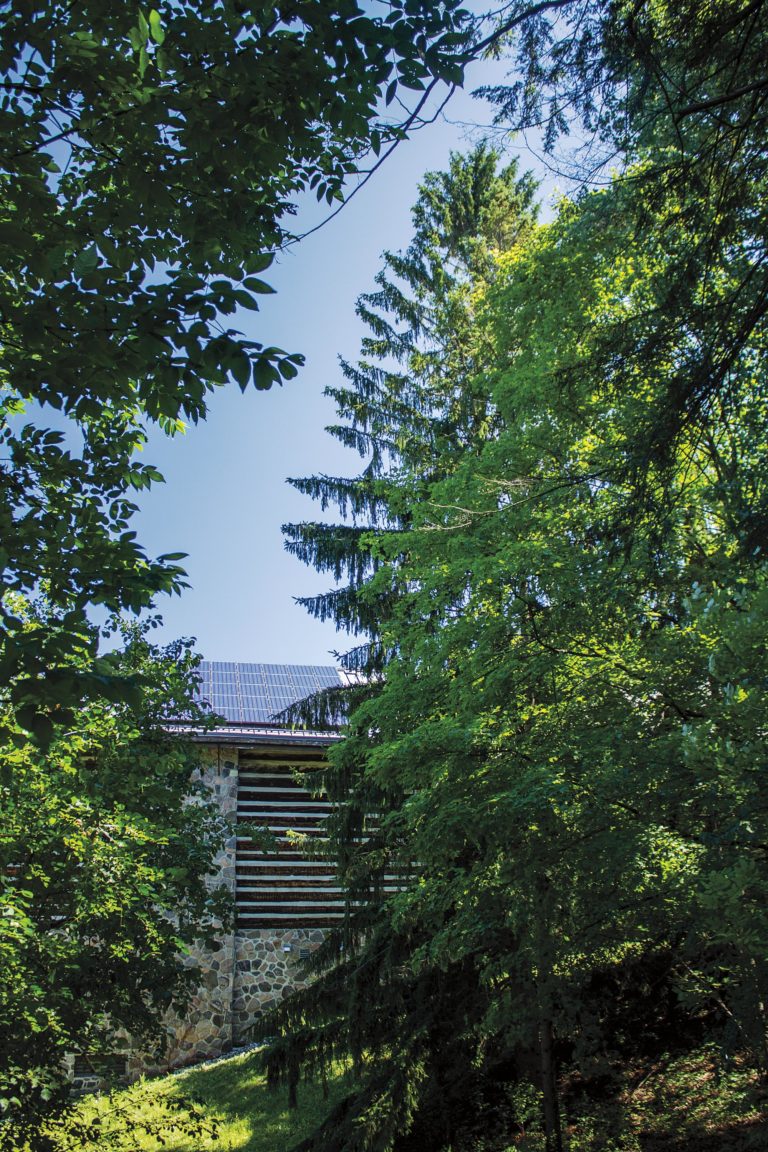 Solar panel array at the McMichael Canadian Art Collection, Canada’s first LEED-certified art institution. Courtesy McMichael Canadian Art Collection.
Solar panel array at the McMichael Canadian Art Collection, Canada’s first LEED-certified art institution. Courtesy McMichael Canadian Art Collection.
Situated on 100 acres of forested conservation land in the Humber River Valley, just north of Toronto, the McMichael Canadian Art Collection has long been dedicated to a notion of stewardship that includes its art holdings and the ecosystems around it. As early as 1991, the gallery’s Board of Trustees approved an updated environmental policy that committed to “responsible environmental management of its property, buildings and operations.” In 2010, it became the first LEED-certified art gallery in Canada and one of the country’s first existing buildings to achieve certification.
Operations Manager Sheri Guevara-Mann and Facilities Manager Ron Fischer greet me in the museum lobby to conduct a walk-through of some of the building’s greener features. Cutting between a permanent-collection exhibition and a photography exhibition about Toronto’s hip-hop culture, Fischer mentions that a majority of the McMichael’s lighting system is LED—about 80 per cent. The heating operates on a closed-loop hydronic system, “which, aside from a geothermal loop,” he says, “is about as efficient as we can get.” The gallery switched over to sensor faucets and water-saving fixtures throughout, notes Guevara-Mann, which helped score big points on that section of the LEED report. All of their cleaning supplies were swapped for EcoLogo-approved products. They created priority “eco-spots” for green vehicles and carpoolers in the parking lot, as well as bike racks for cyclists. Leading our group out a side door and toward where Gallery 8 bumps out and points roughly west over the valley, Fischer stops us in view of the roof. Rising over the tips of nearby pine trees, the slope is covered with a photovoltaic array composed of 78 solar panels. It was installed in 2009, around the time of certification. “Quite significant for its day,” says Fischer.
Guevara-Mann estimates the cost of the retrofits and upgrading was somewhere in the range of $500,000, though she can’t be precise because the McMichael didn’t specifically separate LEED projects from its regular budget at the time. Without that initial figure, it’s difficult to calculate whether the gallery has already recouped the investment in resource and energy savings, but “generally,” Fischer says, “certifying for LEED will save you money.” There’s a misconception that green buildings cost more to construct and operate. When costs overrun, green provisions are often among the first to be slashed. However, if LEED is included from the design phase, Whitred says, a certified building only costs about two per cent more than a building constructed strictly to code. A study conducted by McGraw-Hill Construction, in partnership with the Canada Green Building Council, found that for new green buildings, operating costs decreased 9 per cent in the first year and 17 per cent over five years. Buildings retrofitted for sustainability, on average, saw those same costs go down 8 per cent after the first year and 11 per cent over five years. “A lot of the larger retail and property management organizations in Canada and internationally have found they’re now investing in green buildings as a way to turn a profit,” Whitred says. That’s because sustainability means efficiency, which is also just prudent business practice.
A critical phase of the greening process involves a cultural shift within the workplace about what’s truly needed to perform our duties. This is often how best practices get written.
For all the “re-lamping,” mechanical installs and other switch-outs for higher efficiency and greener solutions, one of the biggest disruptions, Guevara-Mann says, was adopting new paper products. The LEED criteria ask that at least 60 per cent of ongoing consumables like paper, desk accessories and binders come from a minimum 10 per cent post-consumer and/or 20 per cent post-industrial recycled content. “It was difficult to get everyone on board,” she says. The collections department, for example, has specific professional needs in which a recycled option might not suffice or exist. It was a sourcing issue, but it was also an issue of building new habits. “People tend to feel that to do their work they should be allowed to have all the resources they need,” Sutton tells me. “That’s a very professional response.”
Rarely do we ask ourselves, though, if we actually need all the resources we’re demanding. Sutton finds that when she asks people to think about what they use and how they use it, they often find ways to reduce consumption. A critical phase of the greening process involves a cultural shift within the workplace about what’s truly needed to perform our duties. This is often how best practices get rewritten. In the broader field of museums, some institutions have radically embraced this challenge, reducing their impact in ways that significantly reimagine how operations can and ought to run. The Wagner Free Institute of Science, for example, is a natural history museum in Philadelphia that’s adopted a rigorous waste-diversion initiative. In 2016, it was able to recycle 88 per cent of the solid waste that would have normally been sent to landfill. The Phipps Conservatory in Pittsburgh—a 15-acre campus—is powered entirely by renewable energy. What isn’t produced on-site by solar panels and wind turbines is offset by the purchase of renewable energy credits. Like Sutton and McAvity suggested: museums can be role models. One day, an art gallery will be carbon neutral; the vast majority, however, have a way to go.
After viewing the solar array, Guevara-Mann and Fischer bring me through the McMichael’s backrooms and behind Fischer’s computer desk to see what kind of electricity the panels are generating on an overcast May afternoon. They yield about 90 kilowatt-hours on a good day, he says, or enough to power three average Canadian households. He agrees to share last month’s hydro bill to picture what the solar is offsetting (about 1,600 kWh of the 116,000 kWh total consumed in April). Guevara-Mann says she can pull the data from museum archives to see what average annual power usage looked like before LEED upgrades and how it changed after. They seem proud of their efforts as stewards—or at least willing to talk about them. The transparency is refreshing. It represents another cultural shift that’s yet to take place at many other institutions. This is, after all, a story about looking and not looking, and looking does require special effort.
When asked for information both general and practical on sustainability planning and waste and energy management, a number of institutions were unable or unwilling to respond, because the information was difficult to access and couldn’t be retrieved by deadline (National Gallery of Canada), because a key expert wasn’t available during the reporting period (Vancouver Art Gallery), or for some other unspecified reason (Polygon Gallery). Two of the country’s largest institutions, however, were willing to discuss their habits. This was less an exercise in profiling particular operations and what they’re doing or not, and more about sketching the environmental impact of a sector where back-of-house matters rarely receive critical attention.
A plan doesn’t require extra budget for big-ticket investments. From the results [of an energy audit] you can create a triage of actions to reduce usage. Then, the same for waste. Auditing is important; so is sharing.
The Art Gallery of Ontario and the Montreal Museum of Fine Arts are big facilities, totalling 54,348 metres squared and 53,095 metres squared, respectively. It would follow that they use a lot of power. The AGO reports that its average monthly hydro use is approximately 960,000 kWh. At the MMFA, for the service period between mid-April and mid-May of this year, the gallery’s total electricity draw was 700,800 kWh. These figures are substantial, but not double or triple the energy consumption of the average Canadian commercial office. (For an accurate appraisal of the energy intensity of each gallery, a senior policy analyst with Natural Resources Canada tells me, we’d need a much fuller set of consumption data for all fuel types). Both institutions have taken steps to address their efficiency and impact. The AGO has updated most of its lighting system to energy-saving LED bulbs, while the MMFA is actively switching over its stock. The MMFA recently completed considerable upgrades to its HVAC equipment and works with an energy management firm to monitor systems for performance. There’s a dedicated full-time staff member on site, I’m told.
It also seems to follow that larger operations deal with more waste. The AGO purchases somewhere between 1,500 and 2,000 sheets of four-by-eight-foot drywall each year. The average 2,000-square-foot home, to give you some scale, uses about 150 to 200 such sheets. Since 2015, the gallery’s exhibitions and logistics teams have been trying to reduce new construction for installations and focus instead on reusing temporarily built walls and spaces. They’ve begun making leftover construction supplies available to other local galleries and to charity organizations. To handle its construction refuse, the MMFA specially contracts a waste management company that can recycle drywall, which otherwise goes to a landfill. (Instead, it’s turned into fertilizer, according to the waste company’s customer service rep). As per its reporting, the AGO created an average 17.34 metric tonnes of waste, including recyclables, per month in 2017. The MMFA estimates that it routinely sends off one 40-cubic-yard dumpster of sanitary waste per month, another two of dry materials, and about 80 bins—each 80 litres in volume, for paper and cardboard.
This information is illuminating because it evidences an impact the field must contend with. It’s also frustrating because there is virtually no benchmarking data from elsewhere in the sector to analyze it against. Are these galleries performing better or worse than other cultural institutions? It’s difficult to say. Art galleries—the whole museum industry, really—have not been the focus of significant environmental footprint studies, though some are in the works.
The Canadian Conservation Institute, an agency within the Department of Canadian Heritage, is undertaking an energy survey of heritage institutions. At the same time, it’s updating the “Museums, Galleries, Archives, and Libraries” chapter in the ASHRAE Handbook, which influences guidelines around climate conditioning. The 2019 edition will emphasize efficient alternatives to the 70/50 rule, which has been especially onerous for cold-climate institutions. Sutton, too, is working toward a more complete picture of the industry’s net impact. She is the Sector Lead for Cultural Institutions at We Are Still In, a group that includes American companies, schools, cities, counties and states that are still committed to the climate goals of the Paris Agreement, though the United States has formally withdrawn. They’re campaigning for institutions to track and share energy, water and waste data, using a common online tool, to finally establish baselines specific to the performance of museum facilities. “If we were able to say what our impact is,” she explains, “if we were to look at our carbon footprint, we could not ignore our responsibility.” Looking does tend to necessitate action.
“I counsel those who worry about divulging their level of consumption,” Sutton says, “that they need to do it. At the same time, they can say what they’ve done to make a change, what they’re doing now, and what they’re going to do. No one can fault them for having a plan.” A plan doesn’t require extra budget for big-ticket investments. For first steps, she advises an energy audit. From the results you can create a triage of actions to reduce usage. Then, the same for waste. Auditing is important; so is sharing. Institutions must begin the discussion within their organizations, but also with other institutions, and with the public too.
The Coalition of Museums for Climate Justice was formed last year by a group of Canadian museum professionals for just that purpose. They conduct seminars at industry conferences where museum workers are invited to share, in a peer-to-peer learning environment, what they’re doing to promote sustainability. The Coalition intends to “build relationships across sectors between people who are interested in working on the same things,” says advisory group member Naomi Grattan. “The idea is to help people realize that there’s a critical mass of work happening.”
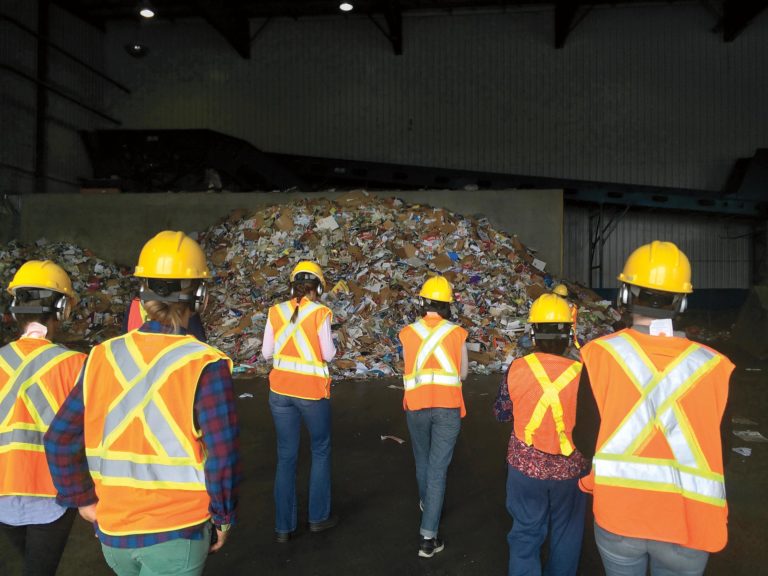 Members of Synthetic Collective at the Materials Recovery Facility in London, Ontario, June 2018. Photo: Kelly Jazvac.
Members of Synthetic Collective at the Materials Recovery Facility in London, Ontario, June 2018. Photo: Kelly Jazvac.
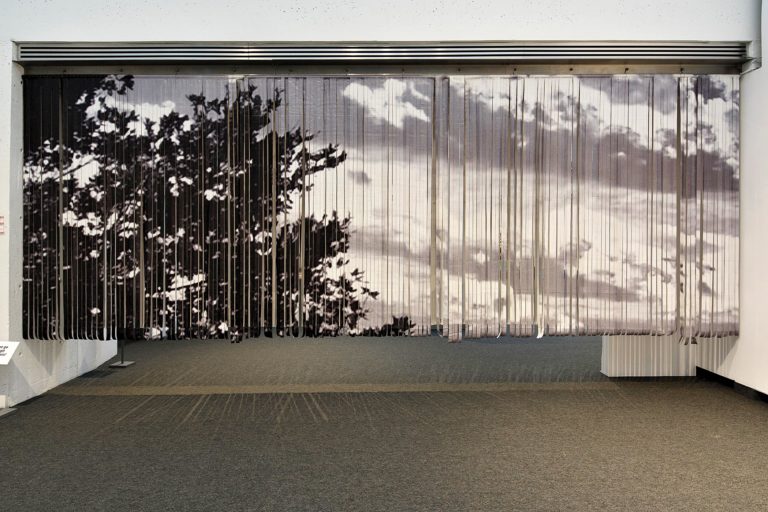 Kelly Jazvac, Browsing, 2016. Salvaged billboard and thread, 2.4 x 6.49 m. Collection of the artist. Courtesy Museum London. Photo: Lucas Stenning.
Kelly Jazvac, Browsing, 2016. Salvaged billboard and thread, 2.4 x 6.49 m. Collection of the artist. Courtesy Museum London. Photo: Lucas Stenning.
The wall text greeting visitors to Kelly Jazvac’s exhibition “Lamina Stamina” at Museum London this summer was drawn there in pencil. Many of the wall hangings were affixed with Velcro—not stuck from the adhesive backing but stapled in place so the strips could be reused (also so that the walls didn’t require significant re-plastering). Sustainability has long been a component of Jazvac’s artistic practice; it also helps guide the way she exhibits her work. She won’t ask for a space to be painted, for example, and considers alternatives when asked to ship heavy works long distances; she doesn’t like constructing new walls, and she won’t print new vinyl lettering.
No person—or institution—is perfect, but to better understand her impact, Jazvac is doing the work of looking. She’s part of an interdisciplinary collaboration called the Synthetic Collective, which brings together scientists, visual artists and cultural workers to, as their website states, “sample, map, understand, and visualize the complexities of plastic and micro-plastic pollution in the Great Lakes Region.” In 2021, the group will present a show at the Art Museum at the University of Toronto with the explicit mission to be as sustainable as possible in their exhibition-making practices. For Jazvac and the other artists involved, whose work looks specifically at environmental contamination, pollution and climate change, it seems hypocritical, she says, not to hold their own artistic output to those same goals and standards of production. A museum exhibition is an ideal space for this sort of experimentation; it’s laden with conventions, but at the same time, it’s open to playing with them.
The seed was planted years ago, Jazvac says, when she was working as an installer for a Toronto gallery. They were tearing down one wall and building another. She met the driver who was there to collect the construction waste, and he asked her, “What goes on in this building? How come they’re doing a renovation every couple of months?” His questions were valid.
Both inside the institutional setting and independent from it, there are individuals and organizations working creatively to reduce and reuse the waste generated by our art activities. In January, curator Suzanne Carte will present an exhibition focused on cultural waste at the Worker’s Art and Heritage Centre in Hamilton, and at the Art Gallery of York University in April. It’ll double as a pick-up event for her Artist Material Fund: throughout the year, Carte collects refuse and surplus goods from local galleries—paint, lumber, catalogues, old lighting—and makes it available for free to artists to reuse in their practices. Concordia University has turned over part of its basement facilities area for the Concordia University Centre for Creative Reuse, or CUCCR (“lovingly pronounced ‘sucker,’” project coordinator Anna Timm-Bottos tells me), where community members can access used material and wares donated from campus facilities. In its first year, the Centre has diverted 7.3 tonnes of material from the landfill.
For the 2021 minimum impact show, the Synthetic Collective will need to ask new questions of old habits. Where is the artwork coming from? What are the environmental costs of transporting it? What resources does its care, installation and display demand? “The plan is that we will try to be as sustainable as possible,” Jazvac says, “and, when we’re not, to be transparent about where we failed.” It is intended to be a space for dialogue; by acknowledging their shortcomings, they are identifying the areas that need greater attention. It’s the case that once you begin looking, there is so much to look at.

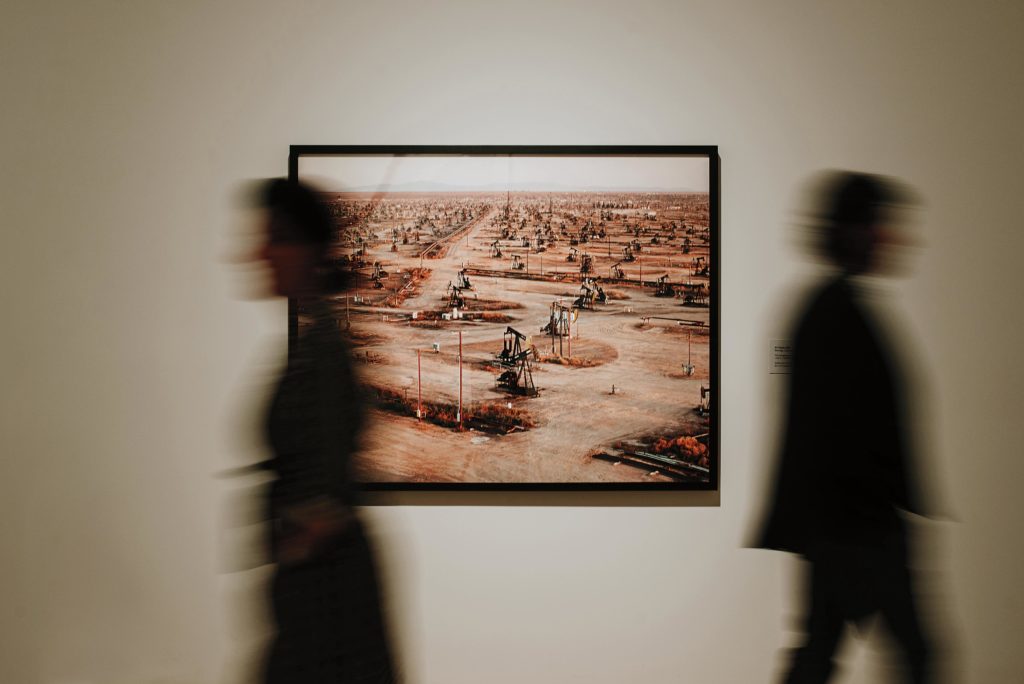 Installation view of Edward Burtynsky’s Oil Fields #18, Belridge, California, USA (2003) at the Audain Art Museum, 2017. Courtesy Audain Art Museum. Photo: Darby Magill.
Installation view of Edward Burtynsky’s Oil Fields #18, Belridge, California, USA (2003) at the Audain Art Museum, 2017. Courtesy Audain Art Museum. Photo: Darby Magill.
